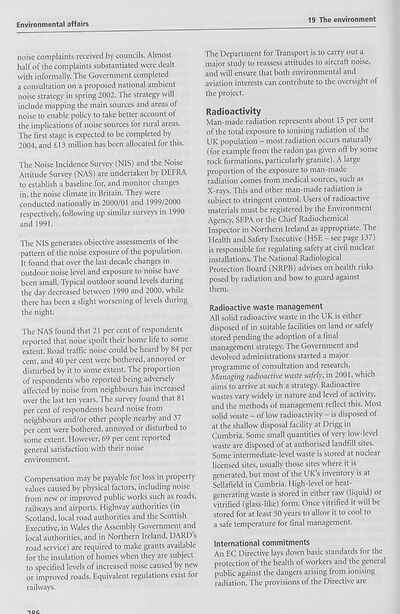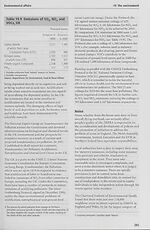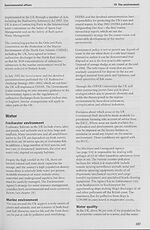Download files
Complete book:
Individual page:
Thumbnail gallery: Grid view | List view

Environmental affairs
19 The environment
noise complaints received by councils. Almost
half of the complaints substantiated were dealt
with informally. The Government completed
a consultation on a proposed national ambient
noise strategy in spring 2002. The strategy will
include mapping the main sources and areas of
noise to enable policy to take better account of
the implications of noise sources for rural areas.
The first stage is expected to be completed by
2004, and £13 million has been allocated for this.
The Noise Incidence Survey (NIS) and the Noise
Attitude Survey (NAS) are undertaken by DEFRA
to establish a baseline for, and monitor changes
in, the noise climate in Britain. They were
conducted nationally in 2000/01 and 1999/2000
respectively, following up similar surveys in 1990
and 1991.
The NIS generates objective assessments of the
pattern of the noise exposure of the population.
It found that over the last decade changes in
outdoor noise level and exposure to noise have
been small. Typical outdoor sound levels during
the day decreased between 1990 and 2000, while
there has been a slight worsening of levels during
the night.
The NAS found that 21 per cent of respondents
reported that noise spoilt their home life to some
extent. Road traffic noise could be heard by 84 per
cent, and 40 per cent were bothered, annoyed or
disturbed by it to some extent. The proportion
of respondents who reported being adversely
affected by noise from neighbours has increased
over the last ten years. The survey found that 81
per cent of respondents heard noise from
neighbours and/or other people nearby and 37
per cent were bothered, annoyed or disturbed to
some extent. However, 69 per cent reported
general satisfaction with their noise
environment.
Compensation may be payable for loss in property
values caused by physical factors, including noise
from new or improved public works such as roads,
railways and airports. Highway authorities (in
Scotland, local road authorities and the Scottish
Executive, in Wales the Assembly Government and
local authorities, and in Northern Ireland, DARD’s
road service) are required to make grants available
for the insulation of homes when they are subject
to specified levels of increased noise caused by new
or improved roads. Equivalent regulations exist for
railways.
The Department for Transport is to carry out a
major study to reassess attitudes to aircraft noise,
and will ensure that both environmental and
aviation interests can contribute to the oversight of
the project.
Radioactivity
Man-made radiation represents about 15 per cent
of the total exposure to ionising radiation of the
UK population - most radiation occurs naturally
(for example from the radon gas given off by some
rock formations, particularly granite). A large
proportion of the exposure to man-made
radiation comes from medical sources, such as
X-rays. This and other man-made radiation is
subject to stringent control. Users of radioactive
materials must be registered by the Environment
Agency, SEPA or the Chief Radiochemical
Inspector in Northern Ireland as appropriate. The
Health and Safety Executive (HSE - see page 137)
is responsible for regulating safety at civil nuclear
installations. The National Radiological
Protection Board (NRPB) advises on health risks
posed by radiation and how to guard against
them.
Radioactive waste management
All solid radioactive waste in the UK is either
disposed of in suitable facilities on land or safely
stored pending the adoption of a final
management strategy. The Government and
devolved administrations started a major
programme of consultation and research,
Managing radioactive waste safely, in 2001, which
aims to arrive at such a strategy. Radioactive
wastes vary widely in nature and level of activity,
and the methods of management reflect this. Most
solid waste - of low radioactivity - is disposed of
at the shallow disposal facility at Drigg in
Cumbria. Some small quantities of very low-level
waste are disposed of at authorised landfill sites.
Some intermediate-level waste is stored at nuclear
licensed sites, usually those sites where it is
generated, but most of the UK’s inventory is at
Sellafield in Cumbria. High-level or heat¬
generating waste is stored in either raw (liquid) or
vitrified (glass-like) form. Once vitrified it will be
stored for at least 50 years to allow it to cool to
a safe temperature for final management.
International commitments
An EC Directive lays down basic standards for the
protection of the health of workers and the general
public against the dangers arising from ionising
radiation. The provisions of the Directive are
19 The environment
noise complaints received by councils. Almost
half of the complaints substantiated were dealt
with informally. The Government completed
a consultation on a proposed national ambient
noise strategy in spring 2002. The strategy will
include mapping the main sources and areas of
noise to enable policy to take better account of
the implications of noise sources for rural areas.
The first stage is expected to be completed by
2004, and £13 million has been allocated for this.
The Noise Incidence Survey (NIS) and the Noise
Attitude Survey (NAS) are undertaken by DEFRA
to establish a baseline for, and monitor changes
in, the noise climate in Britain. They were
conducted nationally in 2000/01 and 1999/2000
respectively, following up similar surveys in 1990
and 1991.
The NIS generates objective assessments of the
pattern of the noise exposure of the population.
It found that over the last decade changes in
outdoor noise level and exposure to noise have
been small. Typical outdoor sound levels during
the day decreased between 1990 and 2000, while
there has been a slight worsening of levels during
the night.
The NAS found that 21 per cent of respondents
reported that noise spoilt their home life to some
extent. Road traffic noise could be heard by 84 per
cent, and 40 per cent were bothered, annoyed or
disturbed by it to some extent. The proportion
of respondents who reported being adversely
affected by noise from neighbours has increased
over the last ten years. The survey found that 81
per cent of respondents heard noise from
neighbours and/or other people nearby and 37
per cent were bothered, annoyed or disturbed to
some extent. However, 69 per cent reported
general satisfaction with their noise
environment.
Compensation may be payable for loss in property
values caused by physical factors, including noise
from new or improved public works such as roads,
railways and airports. Highway authorities (in
Scotland, local road authorities and the Scottish
Executive, in Wales the Assembly Government and
local authorities, and in Northern Ireland, DARD’s
road service) are required to make grants available
for the insulation of homes when they are subject
to specified levels of increased noise caused by new
or improved roads. Equivalent regulations exist for
railways.
The Department for Transport is to carry out a
major study to reassess attitudes to aircraft noise,
and will ensure that both environmental and
aviation interests can contribute to the oversight of
the project.
Radioactivity
Man-made radiation represents about 15 per cent
of the total exposure to ionising radiation of the
UK population - most radiation occurs naturally
(for example from the radon gas given off by some
rock formations, particularly granite). A large
proportion of the exposure to man-made
radiation comes from medical sources, such as
X-rays. This and other man-made radiation is
subject to stringent control. Users of radioactive
materials must be registered by the Environment
Agency, SEPA or the Chief Radiochemical
Inspector in Northern Ireland as appropriate. The
Health and Safety Executive (HSE - see page 137)
is responsible for regulating safety at civil nuclear
installations. The National Radiological
Protection Board (NRPB) advises on health risks
posed by radiation and how to guard against
them.
Radioactive waste management
All solid radioactive waste in the UK is either
disposed of in suitable facilities on land or safely
stored pending the adoption of a final
management strategy. The Government and
devolved administrations started a major
programme of consultation and research,
Managing radioactive waste safely, in 2001, which
aims to arrive at such a strategy. Radioactive
wastes vary widely in nature and level of activity,
and the methods of management reflect this. Most
solid waste - of low radioactivity - is disposed of
at the shallow disposal facility at Drigg in
Cumbria. Some small quantities of very low-level
waste are disposed of at authorised landfill sites.
Some intermediate-level waste is stored at nuclear
licensed sites, usually those sites where it is
generated, but most of the UK’s inventory is at
Sellafield in Cumbria. High-level or heat¬
generating waste is stored in either raw (liquid) or
vitrified (glass-like) form. Once vitrified it will be
stored for at least 50 years to allow it to cool to
a safe temperature for final management.
International commitments
An EC Directive lays down basic standards for the
protection of the health of workers and the general
public against the dangers arising from ionising
radiation. The provisions of the Directive are
Set display mode to:
![]() Universal Viewer |
Universal Viewer | ![]() Mirador |
Large image | Transcription
Mirador |
Large image | Transcription
The item on this page appears courtesy of Office for National Statistics and may be re-used under the Open Government Licence for Public Sector Information.
| Britain and UK handbooks > UK: The official yearbook of the United Kingdom of Great Britain and Northern Ireland > 2003 > (320) |
|---|
| Permanent URL | https://digital.nls.uk/204927270 |
|---|
| Attribution and copyright: |
|
|---|---|
| Description | Three volumes of 'UK: The official yearbook of the United Kingdom of Great Britain and Northern Ireland', published annually by the Office of National Statistics from 2002-2005. |
|---|---|
| Shelfmark | GII.11 SER |
| Description | Three titles produced by the British Government from 1954-2005 describing 'how Britain worked'. They are: 'Britain: An official handbook' (1954-1998), 'Britain: The official yearbook of the United Kingdom' (1999-2001), and 'UK: The official yearbook of the United Kingdom of Great Britain and Northern Ireland' (2002-2005). These 50 reports provide an overview of Britain's economic, social and cultural affairs, its environment, international relations, and the systems of government. They give an impartial summary of government policies and initiatives, and explain how public services are organised. |
|---|---|
| Additional NLS resources: |
|

